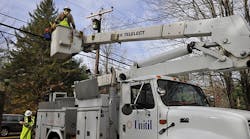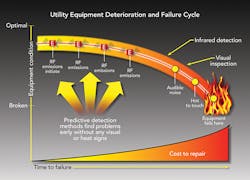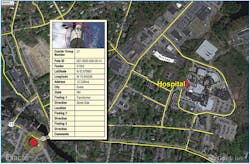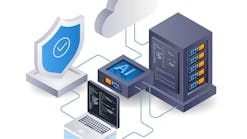In 2013, Unitil began an innovative grid-reliability program aimed at preventing power outages before they occur by replacing deteriorating overhead assets prior to failure. Using predictive technology from Exacter Inc. and data analytics from the utility’s outage management system (OMS), Unitil was able to identify at-risk grid conditions and quantify these points of risk on the overhead system for prioritized equipment replacement.
The question for Unitil was simple: Can predictive methods be a cost-effective tool for improving asset management, and will they show measurable impact on reliability?
A Predictive Approach
By early 2013, East Coast utilities encountered a series of extremely destructive weather events, including Tropical Storm Irene, Superstorm Sandy and an October 2012 snow event. In the wake of this unprecedented string of serious storms, it was becoming clear to Unitil that new measures and approaches were necessary to make its grid more resilient and reliable.
The utility already had success in reducing its system average interruption duration index (SAIDI) through proactive and predictive vegetation management programs. Looking for further improvement led the utility to discussions about other technologies using predictive processes. Unitil turned to a trusted partner, Davey Resource Group. A deep understanding of vegetation enables Davey to predict vegetation growth and enable the strategic targeting of tree trimming in high-growth areas.
In conversations with Davey, Unitil was introduced to Exacter Inc., a predictive technology and analytics company. In the same way Davey uses its understanding of vegetation to predict tree growth, Exacter uses its own proprietary technology and process to identify weak points on the overhead distribution grid and high-risk targets suitable for predictive maintenance.
With the predictive efforts in vegetation management proving successful, it was clear to Unitil there was another opportunity to use this concept to target power outages caused by equipment failure. According to a U.S. Department of Energy study, it is estimated U.S. utilities experience 30% of all non-weather-related power outages as a result of equipment failure. At Unitil, failed equipment accounts for nearly 20% of all interruptions year to date. Although below the national average, equipment failures are the third-largest contributor to outage minutes on the Unitil system, warranting further analysis to determine ways to combat it.
Davey has done a significant amount of due diligence regarding the science and technology behind Exacter, which led Davey to become a strategic partner with Exacter. Unitil’s own due diligence on the technology resulted in the same conclusion and led to a multi-year agreement with Exacter to perform a pilot in the utility’s New Hampshire territory.
An Integrated Program
Before developing a program, Unitil was adamant it had to be customer centric and improve service to customers. For customers, the best reliability strategy is outage avoidance. The question soon became: How can Unitil prevent outages before they occur? This objective was a primary driver that led to the development of an integrated predictive program with Exacter.
To move this innovative program forward, the utility needed the support of New Hampshire regulators. In the wake of outages caused by Superstorm Sandy, regulators were interested in new approaches that would reduce both occurrences and duration of power outages. Their progressive attitude toward new methods enabled the funding that initiated Unitil’s three-year predictive maintenance program with Exacter. The agreement between Unitil and the regulators specified progress reports and observations of the program be presented each year at a Q&A technical session, which would serve to document progress and inform the stakeholders. The ultimate evaluation of the program would follow the three-year pilot.
As of July 2015, Unitil has had two technical sessions with regulators in which the utility presented the first- and second-year results of the program. These meetings have been positive as a result of the shared objective to reduce power outages and improve customer satisfaction as well as the promising results to date. This transparent approach was used when developing Unitil’s successful predictive vegetation programs. The sharing of ongoing progress has built a strong level of trust in the utility’s relationship with regulators. Unitil believes the more engaged and informed regulators are about its reliability strategies, the better understanding the regulators will have when it is time to make decisions about the annual program budgets and rate-case design.
Predictive Technology
At the heart of the predictive program is the ability to gather condition-based field data on the overhead grid. The patented technology identifies failure signature emissions from overhead equipment. Using GPS technology and proprietary analytics, these problematic emissions are located and mapped for further investigation and verification. Since 2007, Exacter has surveyed more than 1 million overhead poles across tens of thousands of miles in the U.S., Canada, Australia, Indonesia and the Pacific islands. The premise is that by removing at-risk equipment from the grid, the overall system reliability is improved and potential failures can be mitigated before they occur.
Unlike visual, corona or infrared photography methods, the Exacter process gathers data over large areas in a short amount of time. For Unitil, it took four weeks to patrol, assess and provide detailed field assessment reports and analytics for more than 428 miles (689 km) of the three-phase overhead grid that constitutes the Unitil system.
The Pilot Program
Unitil’s plan was to gather conditions-based assessment data on a systemwide basis and use the data to develop an overarching predictive maintenance strategy. To demonstrate the impact on reliability, the pilot program would survey the Unitil system once each year for three years. The performance of the grid would be measured annually. The basis for the development of Unitil’s initial pilot program using Exacter technology included several key design elements:
• Repeatable process that could be field proven
• Predictive information that was actionable
• Measurable gains in reducing customer minutes of interruption (CMI)
• Measurable gains in reducing frequency of equipment-related outages
• Regulatory agency involvement and review
• Strategy assessment for annual program.
The Process Begins
Two important targets were set for the Unitil predictive pilot program: reduce the frequency of equipment-related power outages and reduce CMI. To begin the program,
Exacter used Unitil’s most current CMI data for its system. Based on this data, Exacter estimated its program would result in a reduction in SAIDI and CMI of 10% or greater.
The predictive process features seven steps:
- Analysis to identify and quantify opportunities by Exacter
- Prediction of expected results by predictive equipment replacement
- Physical survey and assessment of circuits several times over four weeks
- Field location and verification of deteriorated equipment
- Final report and geographic information system (GIS) compatible files
- Data import into the Unitil OMS
- Prioritized predictive equipment replacement plan based on criticality of findings and program priorities.
With the technology installed in survey vehicles, the system was driven four separate times over a four-week period. After GPS locations of the deteriorated conditions were determined, field locating teams were dispatched using ultrasonic technology to verify the exact pole and piece of equipment that emitted the failure signature. Photographs of the deteriorated equipment were taken and a report was submitted with the images, GPS map location, site description and pole number. In addition, the data was submitted in GIS-compatible formats for integration with Unitil’s OMS.
Within a day of entering the field data, Unitil’s engineers were able to present a report and analysis identifying those problems on critical infrastructure lines as well as the number of customers who would be impacted should an outage occur. This information was then used to prioritize maintenance schedules.
Managing Conditions and Risk
Perhaps the biggest stretch for utilities exploring a predictive program is leaving the mind-set of a run-to-failure strategy. It is a shift in the way overhead assets are managed from a responsive, post-problem approach to a proactive approach where maintenance is triggered by condition-based predictive field data rather than an outage event.
In managing a predictive program, maintenance decisions are driven by information and field intelligence. Being data- and analytic-driven is a mind-set much like the attitude toward maintaining a vehicle. If the vehicle is running hot or a warning light comes on, the operator makes a decision either to live with the risk or attend to the condition. If a homeowner observes a leaking gutter, he or she makes a decision about when or whether to repair the condition. Predictive approaches to grid maintenance operate under the same principle. If there is a predictive indicator of pending failure, a decision must be made. Should it be mitigated now or later to improve the condition of the circuit? Or should the utility live with the risk?
For Unitil, adopting the predictive approach for this three-year pilot was not a leap of faith. It was a well-thought-out decision that involved evaluation of the technology and the track record of other users. The utility looked at the impact potential of positive results and embraced the concept that removing deteriorating components from your system minimizes risk and makes your system stronger, healthier and less susceptible to outages. This principle of removing risks and making continuous improvements is at the heart of a predictive maintenance program and has been a long-standing approach at Unitil.
Because predictive technology and approaches are relatively new, the question remains: How does a utility know when a component will fail? The reality is the utility does not know. With the traditional run-to-failure mind-set, it is black or white — either it is working or it is not. However, the very nature of a predictive paradigm means dealing with shades of gray — indicator data suggesting the probabilistic outcome of a power outage.
For Unitil, the predictive analytics was a powerful tool to gain visibility into what potential problems might exist on its overhead system. While there are still unknowns, a certain number of facts and conclusions about the system exist:
- A particular component at a particular location is exhibiting prefailure conditions.
- The condition is consistent and confirmed by two separate technologies.
- Should an outage occur at that point, the number of customers impacted is known.
- Using Unitil’s average outage time, a calculation can be made on how many customer-minutes would result.
- Using this data, system SAIDI improvement opportunity can be calculated.
- The possible avoided cost of each outage can be calculated.
Logic indicates that by removing the deteriorating component, an at-risk condition has been removed on the grid. Logic also indicates by removing risks from the system, the system is inherently more resilient and reliable. It follows then that, by continuing this process of removing at-risk components, there will be a continuous improvement to the grid’s reliability, which is the basis of Unitil’s decision to pursue a predictive maintenance program.
Removing Functioning Equipment
It may seem counter intuitive to remove a piece of equipment that is still functioning. Unitil linemen have questioned this approach on occasion. For Unitil, the cost of replacing components was not a significant issue because of the limited number of problems found. In year one, the system was surveyed and 56 locations were found involving 62 deteriorated pieces of equipment; that works out to one component every 6.9 miles (11 km). In year two, one component for every 7.4 miles (12 km) was located.
Unitil made the decision to replace all components identified in the surveys. Using the criticality analytics, each point was prioritized and worked into the maintenance schedule. An example of the prioritization includes an issue found on a critical line feeding a local hospital. That particular problem was repaired immediately.
Traditional risk mitigation considers both the probability of an event and the impact. Predictive practitioners must evaluate the cost of the equipment and the maintenance crew, as well as the level of risk and cost of an outage at each problem point. Is a failure on a short circuit impacting a few customers worth prioritizing repair or is it an acceptable risk to delay maintenance? Would knowing about a deteriorated component that could cause a failure that would shut down an industrial park be of interest to a utility?
For Unitil’s predictive program, there were two key priorities in evaluating risk:
- Would an outage at that location impact critical community infrastructure?
- How many customers would be impacted if an outage occurred at that location?
When these variables become part of the equation, it is no longer just about the cost of replacing a component plus the hourly rate of a line crew. The decision becomes about risk mitigation and the cost to replace before failure (or avoided costs) versus the cost of replacing at failure.
Future Applications and Results
Looking ahead, the process of shifting from run-to-failure to conditions-based predictive maintenance has opened new doors for using analytics to review and evaluate asset management, including a quality assurance review of specific component manufacturers, a quality assurance/quality control process of the workmanship of specific line crews or contractors, and the impact of environmental conditions and weather. As a management tool, analytics provides new visibility into the health of overhead assets. This can be important intelligence to have when planning maintenance budgets. Being able to prioritize known problems can eliminate unnecessary maintenance as well as reduce the higher costs of emergency service triggered by outages.
The predictive data has provided new insight into the health of Unitil’s overhead assets, and outages have been avoided because of predictive equipment replacement. Unitil is in the last year of its pilot. In the fourth quarter of 2015, a performance analysis of the program will be completed that compares equipment outage data from all three years against previous years. If the analysis numbers show a meaningful improvement in reducing equipment-related outages, the Exacter program will become part of the ongoing annual budget. Presently, this is what can be shared:
- Exacter estimated a 10% reduction in SAIDI and CMI. Unitil significantly exceeded those numbers after years one and two, although it is hard to determine how much was a direct result of the predictive program alone.
- In 2013, the 62 problems had the potential to create 1.2 million CMI and repairs were made to all 62 components, resulting in a decrease in CMI.
- The number of equipment-related power outages has decreased.
- In 2014, 58 problems had the potential to create 1.5 million CMI and repairs were made to all 58 components, resulting in a decrease in CMI.
- The annual cost to survey, field locate and provide report analytics for the system was $220,000. The annual cost to replace identified equipment has been approximately $50,000 per year.
Raymond Letourneau Jr. ([email protected]) is the director of electric operations and shared services for Unitil, responsible for the construction, operation and maintenance of the electric delivery system. He has 30 years of experience in the utility industry, including working for Public Service of New Hampshire. He has a BSEE degree from Clarkson University, an electric power systems engineering certificate and an MBA.






